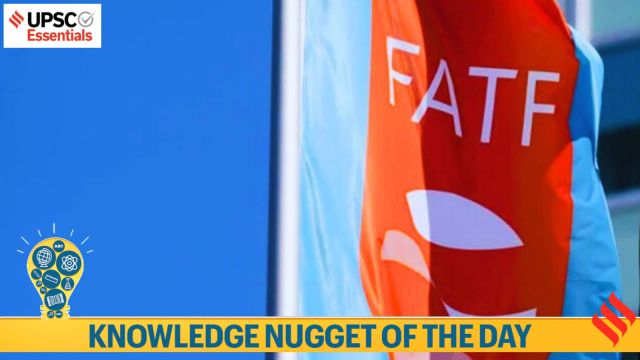Knowledge Nugget | FATF simplified for UPSC: The who, what, and why of the global money laundering and terror financing watchdog
In a fresh bid to mount diplomatic pressure on Pakistan, India is weighing a strategic push to bring Islamabad back onto the Financial Action Task Force’s (FATF) ‘grey list’. Here is all you need to know about the FATF and it's Mutual Evaluation Report on India.
 The FATF is an inter-governmental organisation that underpins the fight against money laundering and terrorism financing by setting global standards and checking if countries respect them. (AP/File)
The FATF is an inter-governmental organisation that underpins the fight against money laundering and terrorism financing by setting global standards and checking if countries respect them. (AP/File)Take a look at the essential events, concepts, terms, quotes, or phenomena every day and brush up your knowledge. Here’s your knowledge nugget for today on Financial Action Task Force (FATF).
Knowledge Nugget: Financial Action Task Force (FATF)
Subject: International Relations
Why in the news?
Following the Pahalgam terror attack, which led to the deaths of 26 people last month, India announced multiple measures in response to Pakistan’s role. In its latest move to ramp up pressure on Pakistan and curb financial flows that aid terror activities, India is planning to bring back Pakistan into the ‘grey list’ of the Financial Action Task Force (FATF), two people in the know told The Indian Express.
Notably, Pakistan was put in the ‘grey list’ in June 2018, and faced “increased monitoring” till it was removed in October 2022. In this context, knowing about the FATF and all aspects related to it becomes essential.
Key Takeaways :
1. The Paris-based intergovernmental organisation FATF is the global money laundering and terrorist financing watchdog. It was formed in 1989 as a G7 initiative to examine and develop measures to combat money laundering. It originally included the G7 countries, the European Commission and eight other countries.
2. According to the official site of FATF, “In April 1990, less than a year after its creation, the FATF issued a report containing a set of Forty Recommendations.” These recommendations aimed to provide a framework of measures to help countries tackle illicit financial flows.
3. The 40 Recommendations are divided into seven distinct areas: (1) AML/CFT Policies and coordination, (2) Money laundering and confiscation, (3) Terrorist financing and financing of proliferation, (4) Preventive measures, (5) Transparency and beneficial ownership of legal persons and arrangements, (6) Powers and responsibilities of competent authorities and other institutional measures, (7) International cooperation.
4. Later, in 2001, the FATF expanded its mandate to also combat terrorist financing. Since 2019, the FATF has had an open-ended mandate, after originally operating under fixed-terms.
5. The Secretariat of FATF is located at the Organization for Economic Cooperation and Development (OECD) Headquarters in Paris. Funding for the FATF Secretariat and other services is provided by the FATF annual budget to which members contribute.
Members of the FATF
1. According to the official site of FATF, there are currently 40 members of the FATF; 38 jurisdictions and 2 regional organisations (the Gulf Cooperation Council (GCC) and the European Commission). There are also 31 international and regional organisations which are Associate Members or Observers of the FATF and participate in its work.
|
Do you know? |
| Although GCC is a full Member of the FATF, five of the individual Member countries of the GCC (Bahrain, Kuwait, Oman, Qatar and the United Arab Emirates) are not. Saudi Arabia is an FATF member since June 2019. |
2. Members of the FATF include Argentina, Australia, Austria, Belgium, Brazil, Canada, China, Denmark, Finland, France, Germany, Greece, Hong Kong (China), Iceland, India, Indonesia, Ireland, Israel, Italy, Japan, the Republic of Korea, Luxembourg, Malaysia, Mexico, the Netherlands, New Zealand, Norway, Portugal, Saudi Arabia, Singapore, South Africa, Spain, Sweden, Switzerland, Türkiye, the United Kingdom, the United States, the European Commission, and the Gulf Cooperation Council. Notably, membership of Russia was suspended on 24 February 2023.
3. India became a member of FATF in 2010. Interestingly, Pakistan is not a member of FATF but of the Asia Pacific Group on Money Laundering (APG), the largest FATF-Style Regional Body. India is a member of APG as well as of the FATF.
Black and Gray lists of FATF
The FATF identifies jurisdictions with weak measures to combat money laundering and terrorist financing (AML/CFT) in two FATF public documents that are issued three times a year. The FATF publicly lists the countries with weak AML/CFT regimes.
📍High-Risk Jurisdictions subject to a Call for Action (i.e. “black list”)
1. Often externally referred to as the black list, it identifies countries or jurisdictions with serious strategic deficiencies to counter money laundering, terrorist financing, and financing of proliferation.
2. According to FATF’s official site, “For all countries identified as high-risk, the FATF calls on all members and urges all jurisdictions to apply enhanced due diligence, and in the most serious cases, countries are called upon to apply counter-measures to protect the international financial system from the ongoing money laundering, terrorist financing, and proliferation financing risks emanating from the country.”
3. As of February 2025, Democratic People’s Republic of Korea, Iran and Myanmar are placed in the black list.
📍Jurisdictions under Increased Monitoring (i.e. “grey list”)
1. Often referred to as the grey list, it identifies countries that are actively working with the FATF to address strategic deficiencies in their regimes to counter money laundering, terrorist financing, and proliferation financing.
2. When the FATF places a jurisdiction in the gray list, it means the country has committed to resolve swiftly the identified strategic deficiencies within agreed timeframes and is subject to increased monitoring.
3. As of February 2025, Algeria, Angola, Bulgaria, Burkina Faso, Cameroon, Côte d’Ivoire, Croatia, Democratic Republic of Congo, Haiti, Kenya, Lao People’s Democratic Republic Lebanon, Mali, Monaco, Mozambique, Namibia, Nepal, Nigeria, South Africa, South Sudan, Syria, Tanzania, Venezuela, Vietnam, Yemen are placed in the gray list.
FATF Mutual Evaluations Reports
1. The FATF monitors countries to ensure they implement the FATF standards fully and effectively. FATF mutual evaluations are in-depth country reports that analyse the implementation and effectiveness of measures taken against money laundering, terrorist and proliferation financing.
|
Terrorist Financing Story continues below this ad |
| Terrorist financing refers to the ways and methods that terrorist organizations use to fund activities that threaten national and international security. Unlike money laundering, which often creates a circular flow of funds that eventually returns to the original source, terrorist financing typically follows a linear path. In this process, the money generated is directed towards supporting terrorist groups and their activities. |
2. The reports are peer reviews, where members from different countries assess another country. After an analysis of a country’s anti-money laundering and counter-terrorist financing system, mutual evaluations give recommendations to further strengthen a country’s system.
|
Proliferation Financing |
| According to the UN, presently, there is no internationally accepted definition of proliferation financing. However, it can be described as providing financial services for the transfer and export of nuclear, chemical, or biological weapons, as well as their means of delivery and related materials. This concept encompasses the financing of trade in proliferation-sensitive goods and may also include financial support for individuals or entities involved in proliferation activities. |
BEYOND THE NUGGET: FATF Mutual Evaluation Report on India
1. The FATF released its Mutual Evaluation Report for India in September, 2024. The report placed India in the “regular follow-up” category regarding its compliance with anti-money laundering and counter-terrorism financing recommendations.
2. However, it highlighted several areas for improvement, including the need to strengthen prosecutions in money laundering and terrorism financing cases, protect the non-profit sector from terrorist abuse, and enhance the supervision and implementation of preventive measures.
|
What is money laundering ? |
| According to the United Nations, money laundering is the processing of criminal proceeds to disguise their illegal origin. This money is generated by a criminal activity but may appear to come from a legitimate source. Money laundering generally involves three key stages to integrate funds into the legal financial system. Story continues below this ad (i) Placement: The crime money is injected into the formal financial system. (ii) Layering: Money injected into the system is layered and spread over various transactions and book-keeping tricks to hide the source of origin. (iii) Integration: Laundered money is withdrawn from the legitimate account to be used for criminal purposes. Notably, it is not necessary for money laundering cases to have all three stages; some stages may be combined, or several stages may repeat multiple times. |
3. Prior to last year’s mutual evaluations report, the FATF had undertaken an evaluation for India in June 2010. India was then placed in the “regular follow-up” category, but was subsequently removed after a follow-up report in June 2013. India’s onsite assessment by FATF happened in November last year, while the assessment came up for discussion in the plenary discussion in June 2024.
4. The “regular follow-up” rating is being seen positively by India, as mostly developing countries fall under the “enhanced follow-up” category, which mandates them to submit reports annually, compared to the once-every-three-years requirement in the “regular follow-up” category.
5. The FATF in its report said that the main sources of money laundering in India originate from within. The “most significant” terror threats seem to be related to the Islamic State or al-Qaeda-linked groups active in and around Jammu and Kashmir.
6. India’s largest money laundering risks are related to fraud including cyber-enabled fraud, corruption and drug trafficking.
Post Read Question
Consider the following statements with reference to the Financial Action Task Force (FATF)
1. It was formed in 1989 as a G7 initiative to examine and develop measures to combat money laundering.
2. India became a member of FATF in 1990.
3. Saudi Arabia and Pakistan are FATF member since June 2019.
How many of the statements given above is/are correct?
(a) Only one
(b) Two only
(c) All three
(d) None
| Answer key |
| (a) |
(Sources: Post Pahalgam terror attack: India works to throttle Pakistan terror funding, get it back in watchdog FATF ‘grey list’, Knowledge nugget of the day: Money Laundering, fatf-gafi.org)
Subscribe to our UPSC newsletter. Stay updated with the latest UPSC articles by joining our Telegram channel – Indian Express UPSC Hub, and follow us on Instagram and X.
🚨 Click Here to read the UPSC Essentials magazine for April 2025. Share your views and suggestions in the comment box or at Manas Srivastava 🚨
Must Read
Buzzing Now


May 19: Latest News
- 01
- 02
- 03
- 04
- 05

























